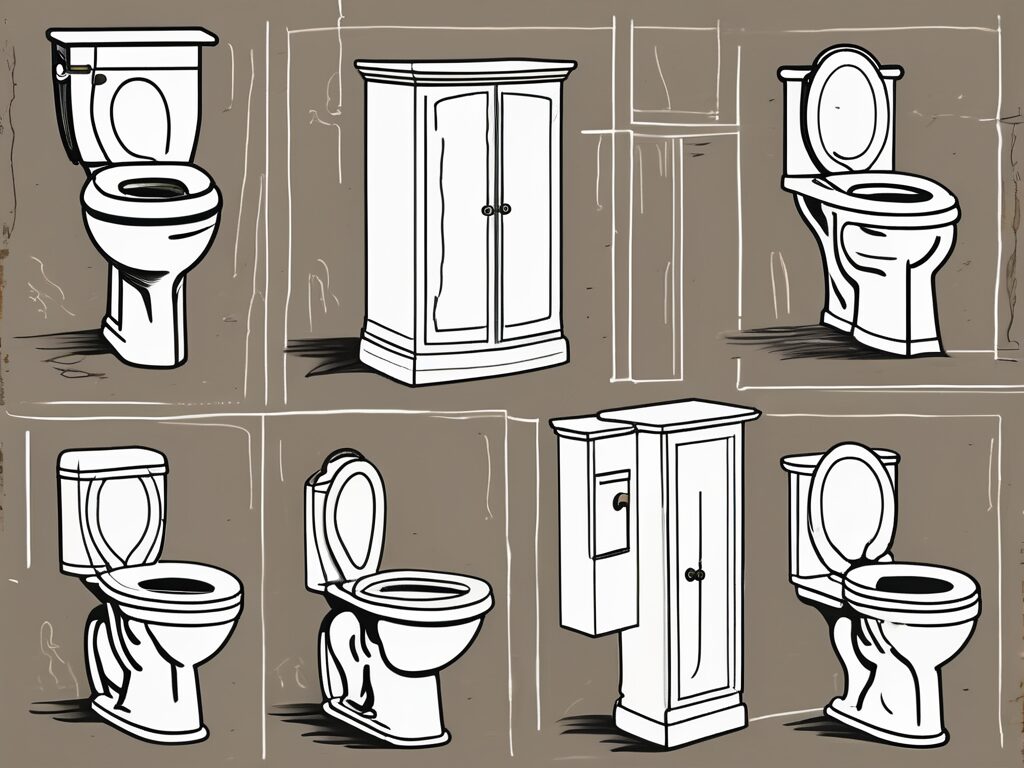
Agent A-Team or Solo Superhero? Finding the Right Real Estate Partner for Your Selling Journey in Wildwood Florida
When it comes to selling your home in Wildwood, Florida,…
January 29, 2024
The water closet, commonly known as the toilet, is a modern invention that has revolutionized our daily lives. In this article, we will take a closer look at the history and significance of the water closet, exploring its evolution, advantages, debunking common myths, and revealing hidden costs. We will also discuss the importance of proper sanitation, space efficiency, and the environmental impact of water closets.
The journey of the water closet can be traced back to ancient times when people used chamber pots or simply relieved themselves in the open. However, it wasn’t until the late 16th century that the first flush toilet, known as the “Valois”, was invented by Sir John Harington, a godson of Queen Elizabeth I.
From that point on, the development of water closets took off. In the 19th century, significant improvements were made, and the first commercial water closets were mass-produced. These early versions showcased porcelain bowls with built-in water tanks and a flushing mechanism, making the task of waste disposal more convenient and hygienic.
As time went on, the water closet continued to evolve. The invention of the S-trap in the early 20th century allowed waste to be easily disposed of through plumbing systems. This innovation paved the way for the modern flushing toilet that we know today, where sewage is efficiently transported away from our homes.
Alongside the technical advancements, the social significance of water closets cannot be ignored. The introduction of indoor plumbing and private bathrooms had a profound impact on public health and hygiene. Access to clean and convenient waste disposal reduced the spread of diseases and improved overall sanitation standards within communities.
Furthermore, the evolution of the water closet also brought about changes in design and aesthetics. In the mid-20th century, designers started incorporating sleek and modern elements into bathroom fixtures. The water closet became not just a functional necessity but also a statement of style and luxury.
Moreover, the development of water-saving technologies in recent years has further transformed the water closet. Dual-flush toilets, for example, allow users to choose between a full flush for solid waste and a reduced flush for liquid waste, conserving water without compromising on performance.
Additionally, advancements in materials and manufacturing techniques have made water closets more durable, efficient, and environmentally friendly. The use of ceramic and other high-quality materials ensures longevity, while improved insulation and water-saving features contribute to energy efficiency and sustainability.
Looking ahead, the future of the water closet is likely to be shaped by ongoing technological innovations. Smart toilets, equipped with sensors and connectivity features, are already entering the market, offering personalized settings, automatic cleaning, and even health monitoring capabilities.
Furthermore, the concept of the water closet is expanding beyond traditional bathroom spaces. In modern architecture and interior design, there is a growing trend towards open-plan living, where bathrooms seamlessly blend with other areas of the home. This integration of the water closet into the overall design aesthetic reflects changing lifestyles and a desire for more versatile and adaptable living spaces.
In conclusion, the evolution of the water closet has been a fascinating journey, from the humble chamber pot to the modern marvels of technology and design that we have today. As our understanding of sanitation and comfort continues to evolve, so too will the water closet, adapting to meet the needs and desires of future generations.
One of the key advantages of water closets is the privacy they provide. Compared to open pit toilets or shared latrines, having a personal water closet allows individuals to maintain their dignity and modesty. It creates a more comfortable and hygienic environment for relieving oneself.
Imagine a scenario where you are in a public place and suddenly feel the urge to use the restroom. You walk into a water closet, close the door behind you, and instantly feel a sense of relief knowing that you have complete privacy. No more worrying about someone accidentally walking in or feeling self-conscious about the sounds and smells associated with using the toilet.
Not only do water closets offer privacy, but they also provide numerous hygiene benefits. In a shared latrine, you may encounter unsanitary conditions due to the lack of regular cleaning and maintenance. However, with a water closet, proper sanitation practices are easier to implement and maintain.
Proper sanitation practices in water closets play a crucial role in maintaining public health. Regular cleaning and disinfection are essential to prevent the spread of harmful bacteria and viruses. Imagine a world where water closets were not properly cleaned and sanitized. The risk of contracting diseases such as E. coli, norovirus, or even hepatitis A would be significantly higher.
Thankfully, most establishments take sanitation seriously and have dedicated cleaning staff who ensure that water closets are kept clean and hygienic. They use effective cleaning agents to eliminate any potential pathogens and maintain a safe environment for users.
Additionally, the use of toilet seat covers or cleaning wipes can further minimize the transfer of germs between users. These simple yet effective measures provide an extra layer of protection, giving users peace of mind knowing that they are taking steps to protect their health.
Furthermore, modern advancements in water closet design have introduced features like bidets and self-cleaning mechanisms. These additions enhance personal hygiene and further reduce the potential for the spread of diseases. Bidets, for example, provide a gentle and thorough cleansing experience, eliminating the need for excessive toilet paper usage. This not only reduces the risk of contamination but also contributes to environmental sustainability.
Self-cleaning mechanisms, on the other hand, ensure that the water closet is sanitized after each use. These mechanisms use powerful disinfectants and cleaning agents to eliminate any remaining bacteria or viruses, leaving the toilet clean and ready for the next user.
In conclusion, water closets offer not only privacy but also significant hygiene benefits. Proper sanitation practices, including regular cleaning, disinfection, and the use of additional hygiene features, contribute to a safer and healthier environment for all users. So the next time you step into a water closet, take a moment to appreciate the advantages it provides and the efforts made to ensure your well-being.
There is a common misconception that water closets take up valuable space in bathrooms. However, this is not necessarily true. With careful planning and design, water closets can actually optimize space efficiency, especially in smaller bathrooms.
When it comes to small bathrooms, every square inch counts. That’s why homeowners and designers are constantly seeking innovative ways to make the most of limited space. One of the key elements in this pursuit is the water closet, commonly known as the toilet.
While it’s true that toilets do require a certain amount of floor space, modern advancements have made it possible to incorporate them seamlessly into bathroom designs without compromising functionality or aesthetics. The key lies in maximizing space efficiency through thoughtful selection of fixtures and clever storage solutions.
By choosing space-saving fixtures and utilizing clever storage solutions, small bathrooms can accommodate water closets without sacrificing functionality or aesthetics. Compact toilets, wall-mounted sinks, and creative shelving options are just some of the many strategies available to maximize space utilization.
Compact toilets, for instance, are specifically designed to fit into tight spaces. These toilets feature a shorter depth and narrower width, allowing them to be installed in areas where a standard-sized toilet would be impractical. Despite their smaller size, compact toilets still offer the same level of comfort and performance as their larger counterparts.
Another space-saving option is the wall-mounted sink. These sinks are attached directly to the wall, eliminating the need for a bulky vanity or cabinet. By freeing up floor space, wall-mounted sinks create a more open and spacious feel in the bathroom. Additionally, they can be paired with wall-mounted faucets to further enhance the sleek and minimalist aesthetic.
In addition to choosing the right fixtures, creative storage solutions can also play a significant role in maximizing space efficiency. For example, installing floating shelves above the toilet or utilizing vertical storage units can provide additional storage space for toiletries, towels, and other bathroom essentials. These storage options not only keep the bathroom organized but also make use of otherwise unused wall space.
Furthermore, incorporating built-in niches or recessed shelves into the shower area can eliminate the need for bulky shower caddies or shelves, freeing up even more space. These built-in storage solutions seamlessly blend into the overall design, creating a clean and streamlined look.
When it comes to small bathrooms, the key is to think outside the box and explore innovative ways to maximize space efficiency. Water closets, far from being a waste of space, can actually contribute to a well-designed and functional bathroom. By choosing space-saving fixtures and implementing clever storage solutions, homeowners can create a bathroom that not only meets their needs but also makes the most of every square inch available.
While water closets offer numerous benefits, it’s important to be aware of the potential hidden costs associated with their maintenance and installation.
When it comes to water closet maintenance, there are several factors to consider. Regular cleaning is essential to ensure proper hygiene and prevent the buildup of bacteria and odors. This may require the purchase of specialized cleaning products or hiring professional cleaning services, adding to the overall maintenance expenses.
In addition, the longevity of a water closet can be influenced by various factors such as the quality of materials used, the frequency of use, and the level of care taken. Over time, components such as valves, seals, and flushing mechanisms may wear out and require replacement. These replacement parts can add up in terms of cost, especially if they need to be sourced from specific manufacturers or suppliers.
When upgrading or installing a water closet, it is wise to consider factors such as water efficiency, durability, and ease of maintenance. Investing in high-quality fixtures and accessories can save money in the long run by reducing repair and replacement costs.
Furthermore, it is important to consider the installation expenses associated with water closets. Depending on the complexity of the installation, professional plumbing services may be required, adding to the overall cost. Additionally, if the existing plumbing infrastructure needs to be modified or upgraded to accommodate the water closet, this can further increase the installation expenses.
Water closets, especially traditional flush toilets, consume a significant amount of water with each use. This raises concerns about the environmental impact and the strain on water resources.
Fortunately, there are greener alternatives available. Low-flow toilets, for example, are designed to use less water per flush while still maintaining effective waste disposal. Dual-flush systems provide users with the option to choose between a full flush for solid waste and a reduced flush for liquid waste, further conserving water.
Another eco-friendly option is composting toilets. These systems use natural processes to break down waste into compost, which can then be safely used as fertilizer. Composting toilets not only save water but also contribute to sustainable waste management practices.
In conclusion, the water closet has come a long way since its humble beginnings as a chamber pot. Its evolution has brought about improved sanitation, privacy, and hygiene benefits. While there may be hidden costs and environmental considerations to be mindful of, the overall significance and impact of water closets on our daily lives cannot be understated. It is a testament to human ingenuity and our commitment to enhancing the well-being of individuals and communities alike.

If you want the Richr team to help you save thousands on your home just book a call.
 Book a call
Book a call